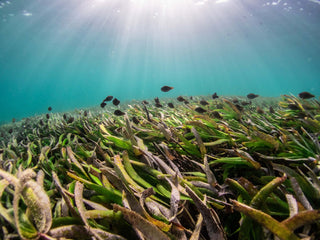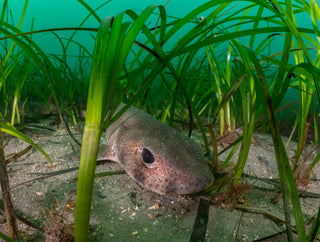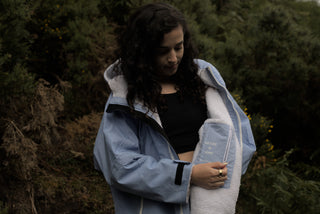Hidden beneath the shimmering surface of our oceans lies a vital and underappreciated ecosystem known as seagrass. While coral reefs and rainforests often steal the limelight, seagrass meadows play a critical role in maintaining the health of our planet. These submerged flowering plants create a dynamic and diverse habitat that supports an array of marine life and provides numerous ecological benefits.
In the UK alone, it is believed that we have lost up to 90% of our seagrass meadows in the past century and in just 40 years, we’ve lost one third of seagrass meadows globally.
Inhabit are proud to be supporting Project Seagrass, a UK registered charity working across the globe to restore these incredible ecosystems.
Read our full eco-mission here.


Importance of Seagrass Habitats
Seagrass meadows serve as an oasis for an astonishing array of species. These vibrant habitats provide shelter, food, and breeding grounds for a vast range of marine organisms, including fish, crabs, seahorses, and sea turtles. Many commercially important fish species, such as cod and snapper, depend on seagrass for their early life stages. By nurturing a rich and diverse array of marine life, seagrass contributes to the overall stability and resilience of the marine ecosystem.
Beyond supporting marine life, seagrass plays a crucial role in mitigating climate change. These underwater plants are incredibly efficient at sequestering carbon dioxide from the atmosphere through the process of photosynthesis. Despite covering less than 0.2% of the ocean floor, seagrass meadows are estimated to store around 10% of the ocean's carbon. This significant carbon sink helps to reduce the impacts of greenhouse gas emissions and plays a vital role in regulating our planet's climate.
Seagrass acts as a natural defence system along coastlines, protecting them from erosion and storm damage. The intricate root systems of seagrass plants stabilise sediments and prevent them from being washed away by currents and tides. By acting as a buffer, seagrass meadows can help minimise the impact of coastal storms and reduce the risk of flooding in adjacent communities. Their presence also helps maintain water clarity, allowing sunlight to penetrate the water and support other marine ecosystems, such as coral reefs.
Threats to Seagrass Ecosystems

Unfortunately, these unique and vital ecosystems are facing numerous threats that endanger their existence and the marine life they support.
One of the primary threats to seagrass ecosystems is coastal development. As human populations continue to grow, coastal areas are increasingly being transformed for urbanisation and industrial activities. Construction of harbours, marinas, and coastal infrastructure often involves dredging and land reclamation, leading to the destruction of seagrass beds. Pollution from construction activities, increased sedimentation, and alterations in water flow patterns also negatively impact seagrass habitats.
Excessive nutrient pollution, primarily from agricultural runoff and sewage discharge, poses a significant threat to seagrass ecosystems. High levels of nitrogen and phosphorus in the water fuel algal blooms, which block sunlight and impede seagrass photosynthesis. This phenomenon, known as eutrophication, leads to seagrass decline and eventual die-off.
Overfishing and destructive fishing practices pose a direct threat to seagrass ecosystems. Bottom trawling, the use of dynamite, and unsustainable harvesting techniques damage seagrass beds and uproot the plants. Some fishing gear, such as dragnets and seines, can also inadvertently catch and damage seagrass meadows. The loss of seagrass habitat affects the abundance and diversity of fish and invertebrate species that rely on these areas for feeding, shelter, and breeding.
The Work of Project Seagrass
Formed in 2013, Project Seagrass have been committed to putting a stop to the loss of seagrass whilst ensuring that the benefits they provide communities are sustained now and for the future. Their projects align with their three core pillars; Community, Research and Action.
With the sale of each robe, we contribute funds equal to planting three seagrass seeds - one for each of their pillars.
Community
Project Seagrass understands the importance of involving local communities in conservation programmes, generating both an awareness and understanding of these ecosystems. Education is the key to conservation, and they work collaboratively across many sectors to inspire the next generation and advance the conservation of seagrass and the wider marine environment.
One such example of this work is a project funded by Synchronicity Earth, which supported the roll out of the unique SeagrassSpotter App in Southeast Asia. Through the means of citizen science, the app allows communities, organisations and individuals to engage more with seagrass meadows whilst contributing to a global database to inform local and regional management and conservation efforts.
Research
Bringing together some of the worlds best seagrass scientists, Project Seagrasses research focuses on basic and applied research into the structure, function and resilience of seagrass meadows with projects in Europe, across the Indo Pacific and the Caribbean. The team have proudly led and contributed to over 80 peer-reviewed scientific articles.
To learn more about these important studies, and how they are advancing our understanding of seagrass, visit their publications page.
Action
With a strong belief in the UN Global Goals, Project Seagrass work with a huge range of organisations to monitor and restore seagrass ecosystems, from replenishing damage seagrass meadows in Wales, helping pioneer Scotland's first community led seagrass restoration project to developing a blueprint for upscaling the restoration of seagrass to enhance the resilience of estuarine and coastal waters in England.

Why We Care
For more information on the vital work carried out by Project Seagrass, click here to visit their Programmes page or find out ways that you can get involved.
Our planet, Earth, is where we call home. At some point in the past, we had a deep understanding of and strong connection with our natural surroundings, enabling effective communication and comprehension of the world around us. However, as time has progressed, we seem to have lost that connection.
Our relationship with nature has weakened, leading to a significant transformation in our emotional, cognitive, and behavioural patterns.
The primary objective of Inhabit is to rekindle our association with nature and emphasise the importance of living in a state of mindfulness. This involves being aware of our thoughts, emotions, conduct, and surroundings, and intentionally occupying them. We encourage individuals to consciously embrace their surroundings and make a concerted effort to be mindful of their impact on the environment.
We believe that biodiverse habitats are the key to this solid connection. That is why we donate a percentage of each sale to organisations that work to restore and rewild our planets most vital habitats.
